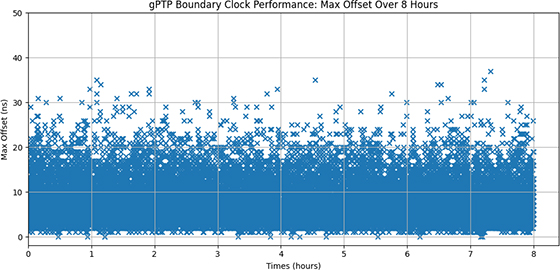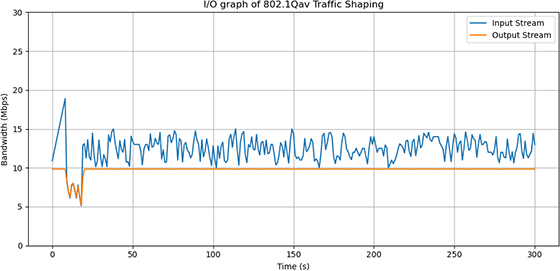Bring Real-Time Efficiency to Every Warehouse Layer with NEXCOM Fast Time-Sensitive Networking Activation Kit
The Trend
As global supply chains accelerate, modern warehouses have become more than storage spaces—they are dynamic, data-driven ecosystems. Whether in a component warehouse feeding just-in-time production, a finished goods warehouse balancing inventory and demand, or a high-throughput fulfillment center managing thousands of daily shipments, seamless coordination between machines is critical.

Every robotic lift, automated conveyor, and vision-guided scanner must move with split-second accuracy, synchronized across floors and aisles. Time-sensitive networking (TSN) has emerged as the key to achieving this precision without the need to isolate or rebuild entire automation networks.
Warehouses are rapidly adopting multi-layer automation:
- Vertical storage systems optimize space through robotic lifts and shuttles.
- Vision-based conveyors identify, weigh, and track items in motion.
- Autonomous mobile robots (AMRs) handle flexible routing between docks.
- AI analytics continuously predict and adjust workflows.
However, these systems depend on real-time interaction across diverse equipment generations. Any delay or misalignment between data streams disrupts not only operations but also the predictive algorithms driving efficiency. The emerging trend is clear — synchronization, not just connectivity, defines warehouse intelligence.
The Challenge
Traditional industrial Ethernet networks were designed for connectivity — not simultaneity. As warehouses evolve into multi-system environments, hundreds of devices must act within coordinated time frames: robotic shuttles, conveyors, elevators, cameras, scanners, and weighing stations often exchange data within microseconds. Yet, when these devices run on separate clocks or unsynchronized fieldbus islands, timing drift accumulates across the network.
The result is a chain of costly inefficiencies:
- Mechanical desynchronization — a robotic lift may arrive milliseconds early before a conveyor completes positioning.
- Vision and ID mismatch — barcode or camera systems record the same package twice, or miss it entirely, because timestamp offsets cause data overlap or gaps.
- Inventory ghosting — asynchronous signals between sensors and MES systems result in discrepancies between physical and digital stock counts.
In high-density vertical storage, clock misalignment are amplified by network latency variation between stacked floors or temperature zones. Each local controller may appear to operate normally, but when the system acts as one — even a 50 ms deviation can cascade into collisions, missed handoffs, or incorrect sorting, creating a butterfly-effect chain of failures across the line.
NEXCOM Solution
Deploying rugged 16-port TSN switch as a time distribution gateways enable unified, sub-microsecond synchronization across the entire warehouse network. Acting as the gPTP grandmaster, the switch distributes precise timing between automation assets—from robotic lifts and conveyors to cameras and AI edge controllers.
With NEXCOM adaptive and scalable TSN platform – ISA 142 – both new and legacy systems are able to operate under a shared, deterministic time domain, eliminating drift and enabling real-time orchestration of warehouse operations. ISA 142 provides a deploy-ready foundation for industrial synchronization, engineered as a high-density OT security switch, the ISA 142 combines robust hardware and NEXCOM TSN Switch Suite software—creating a TSN solution that is both precise and practical.
Powered by Intel’s quad-core Atom® x6413E processor, ISA 142 offers three 1GbE copper ports and up to sixteen switch ports for multi connectivity and scalability. Its compact, rugged design allows deployment in densely packed control zones, connecting up to 16 mission-critical devices that demand deterministic timing and enhanced security.
NEXCOM TSN Switch Suite
NEXCOM applies a hybrid TSN strategy that pairs proven open-source gPTP software stack with hardware timestamping for nanosecond precision, while configuring TSN schedulers directly in silicon for low-overhead, predictable traffic shaping:
- For algorithm-intensive tasks, such as clock synchronization and path delay calculations under IEEE 802.1AS, NEXCOM leverages open-source software like ptp4l, while utilizing switch hardware’s timestamping engine for accuracy.
- For hardware-supported functions, such as IEEE 802.1Qav and IEEE 802.1Qbv, NEXCOM’s lightweight configuration tools directly program the switch, eliminating unnecessary software layers.
The key software components of NEXCOM TSN Switch Suite package are summarized in Table I.
TABLE I
COMPONENT FUNCTIONALITY AND TYPE
|
Component
|
Function
|
Type
|
|
ptp4l
|
The open-source daemon that implements the
IEEE 802.1AS protocol logic. |
Open Source
|
|
ncs_ptp_ctl
|
A utility for creating and
managing the virtual interfaces needed by NEXCOM Virtual Interface Driver. |
NEXCOM TSN
Switch Suite |
|
ncs_mv_qav
|
A lightweight utility for configuring 802.1Qav
(Credit-Based Shaper) parameters. |
NEXCOM TSN
Switch Suite |
|
ncs_mv_qbv
|
A lightweight utility for configuring 802.1Qbv
(Time-Aware Shaper) gate control lists. |
NEXCOM TSN
Switch Suite |
|
NEXCOM Virtual
Interface Driver |
A custom kernel driver that exposes the
Marvell chip's PTP engine to ptp4l. |
NEXCOM TSN
Switch Suite |
With the NEXCOM TSN Switch Suite OT engineers are able to quickly and easily configure TSN traffic control, including IEEE 802.1Qav and IEEE 802.1Qbv. By simplifying standard Linux interface, the suite reduces setup time, eliminates unnecessary configuration complexity, and allows industrial networks to achieve deterministic performance rapidly—even in environments with mixed legacy and modern devices.
Testing and Validation
- IEEE 802.1AS
Timing and Synchronization for Time-Sensitive ApplicationsISA 142 was tested as both boundary clock and master in an 8-hour synchronization chain. Setup was simplified using NEXCOM TSN Switch Suite CLI tools (ncs_ptp_ctl) and open-source ptp4l protocol, reducing configuration complexity.
Validation was performed using the topology in Figure 1.

Figure 1. IEEE 802.1AS (gPTP) test topology.
Test results are presented in Figures 2.1–2.3. ISA 142 achieved an average offset of 7.97 nanoseconds (ns) with a maximum deviation of 37ns; NSA 7135 recorded an average offset of 5.72ns with a 36ns maximum deviation; and NSA 5181 showed an average offset of 9.11ns with a maximum deviation of 37ns.

Figure 2-1. ISA 142 boundary clock IEEE 802.1AS test results (avg. 7.97ns, max. 37ns).

Figure 2-2. NSA 7135 slave 1 IEEE 802.1AS test results (avg. 5.72ns, max. 36ns).

Figure 2-3. NSA 5181 slave 2 IEEE 802.1AS test results (avg. 9.11ns, max. 37ns).
Achieved results demonstrate high stability and prove that ISA 142 with NEXCOM TSN Switch Suite ensure nanosecond-level precision across the full synchronization chain.
- IEEE 802.1Qav
Forwarding and Queuing Enhancements for Time-Sensitive Streams
ISA 142 was evaluated under IEEE 802.1Qav using NEXCOM TSN Switch Suite to simplify setting a fixed 10 Mbps rate limit, while a variable 12 Mbps input stream was transmitted through traffic generator.
Validation was performed using the topology in Figure 3.

Figure 3. IEEE 802.1Qav test topology.
As shown in Figure 4, the output stream (orange) remained perfectly regulated at 10 Mbps, even as the input stream (blue) consistently exceeded the limit—demonstrating precise rate enforcement and bandwidth assurance for prioritized traffic.

Figure 4. I/O graphs for 802.1Qav test.
Test results verifies ISA 142’s ability to strictly enforce traffic shaping and maintain deterministic performance, ensuring that critical data flows are consistently protected from congestion and latency spikes.
- IEEE 802.1Qbv
Enhancements for Scheduled Traffic Time-Aware ShaperISA 142 compliance with 802.1Qbv was tested with an 800 µs / 200 µs two-state gate cycle, using the topology shown in Figure 5. A high-priority (P5) 12 Mbps stream and a low-priority (P1) 100 Mbps stream were transmitted simultaneously to evaluate time-based traffic isolation.

Figure 5. IEEE 802.1Qbv test topology.
After enabling the schedule, the 200 µs window was allocated to P5 traffic and the 800 µs window to P1 traffic, set through ncs_mv_qbv (component of NEXCOM TSN Switch Suite). The results are shown on Figure 6 and clearly demonstrate precise time-slot isolation: when P5 was active, P1 was completely blocked, and vice versa.

Figure 6. Traffic output with and without 802.1Qbv enabled.
The test confirmed ISA 142 suitable for deterministic operation through time-gated transmission—achieving uniform delivery intervals, isolating time-critical and background traffic, and ensuring predictable, real-time network performance essential for automation workloads.
Overall, the tests confirm that ISA 142 delivers standard-compliant, precise, and deterministic performance across key TSN functions.
Conclusion
In next-generation warehouses, precision timing defines operational intelligence. By introducing TSN-based synchronization and traffic control at the network layer, operators can achieve true real-time coordination across automation tiers, linking motion control, sensing, and AI-driven decision-making and more.
NEXCOM’s ISA 142 is able to deliver timing accuracy and deterministic performance required for faster, safer, and more reliable operations. Test results proves ISA 142 with NEXCOM TSN Switch Suite is ready for real-world industrial deployment brining nanosecond-level synchronization, stable traffic shaping, and deterministic scheduling, allowing developers to focus on their applications rather than low-level integration.
- Related Links:
- Achieve Faster AI Insights with NEXCOM FTA 5190 and Xeon® 6 SoC
- NSA 5200 Provides Scalable AI Security for Threat Detection and Encrypted Networks
- Browse Other News:
- AIEdge-X®80 Leaps Ahead: Power Up TOPS Performance with NVIDIA® Jetson™ Super Mode
- Built for the Long Haul: VMC 2030 Redefines Rugged Computing for Mining Vehicles
- All White Papers News
